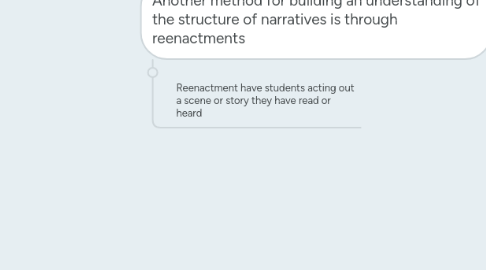
1. Nature of Text: a text has content and organization
1.1. Knowing Organization: provides path for making an outline of a story or informational piece
1.1.1. A reader with a good idea of story organization can use it as a framework for remembering it
1.2. Knowing Content: When students read, they transform text into ideas or details known as propositions
1.2.1. propositions form a macrostructure
1.2.1.1. macrostructure is a running summary of the text
1.3. Narrative Text and Story Schema
1.3.1. Story schema: an internal sense of story that continually grows, and individuals use to guide them through a tale, remember the selection, and write their own stories
1.3.1.1. Story grammars: a kind of scheme that analyzes a story into parts that tend to concentrate on setting, characters, and plot.
1.3.2. Narrative Texts: narratives progress mostly by the main character's goals, the reader comprehends the story in terms of the main character's attempts to resolve a problem or conflict
1.3.2.1. Narratives differ in orientation such as action-oriented and consciousness-oriented narratives
1.3.3. To build a sense of story: the most effective strategy is to read aloud to students from a variety of materials, most children gain a sense of story from this exposure, but it is helpful to highlight major structural elements, which can be accomplished by discussing the story's setting, characters, plot and main problem
1.3.3.1. Asking what, how, and why questions highlight major structural elements
1.3.3.2. Another tool for teaching story structure is to have students fill out generic guide sheets and story maps as they ask students to read closely so as to complete the maps and require self-monitoring
1.3.3.3. The different types of development present in picture books can be used to show the variety of narrative structures
1.3.4. Comprehension of narratives: fostering comprehension of narratives requires being aware of the students' level of knowledge of narratives which can be assessed by asking them to retell a familiar story or to compose a story based on a wordless picture book
1.3.4.1. Also take into account that fostering the comprehension of narratives also requires being aware of the students' culture as European American, African American, and Japanese American all recount stories in their own way
1.4. Expository Text
1.4.1. Expository text is writing that is designed to explain or provide information
1.4.1.1. Expository text has a great variety of organizations patterns and young students have limited experience hearing and reading it
1.4.1.2. Expository text is based on a complex logical scientific style
1.4.1.3. A mix of narrative and expository text is needed to promote a full range of thinking and comprehension skills
1.4.1.4. A key to comprehension of expository text is understanding the text structure, which is the way the author has organized his or her ideas
1.4.1.4.1. Often content dictates structure
1.4.1.4.2. Knowledge of structure has a three benefits: It focuses attention on individual ideas, it provides a clearer view of the relationship among ideas, and it is a framework to aid retention of information
1.4.1.5. The types of Expository text structures
1.4.1.5.1. 1. Enumeration-description: this type provides details about a subject without giving any cause-effect or time relationship among them
1.4.1.5.2. 2. Time sequence: this type specifies time order with such words as after, today, afterward, etc
1.4.1.5.3. 3. Explanation-process: this type provides an explanation of how something works, steps in a process are stressed
1.4.1.5.4. 4. Comparison-contrast: this type presents differences and similarities through words such as similar and on the one hand
1.4.1.5.5. 5. Problem-solution: this type has a statement of a problem followed by a possible solution or series of solutions
1.4.1.5.6. 6. Cause-effect: an effect is presented along with a single cause or a series of causes
1.4.1.6. Teachers are advised to model for students how to figure out the author's structure and allow students to practice finding it on their own
1.4.1.7. Teaching expository text structure: being aware of how a text is structured will help readers build a coherent representation of the text
1.4.1.7.1. A method to achieve that is the CORE model (Connect, Organize, Reflect, Extend)
2. Another method for building an understanding of the structure of narratives is through reenactments
2.1. Reenactment have students acting out a scene or story they have read or heard
3. A helpful tactic for boosting comprehension and awareness of text structure is retelling
3.1. It has been proved to provide a sense of text structure for average and struggling learners
3.2. There are types of retelling that aim to develop retelling abilities in order to improve students' comprehension of selections
3.2.1. Pretelling: at this level, students learn to explain everyday tasks such as making a sandwich
3.2.2. Guided reading: this level comes after students have the ability to retell the key steps in an activity, students use illustrations and then artifacts to retell the story
3.2.3. After mastering retelling with illustrations and artifacts, students can use story maps or graphic organizers to aid their retelling which help students pick out important elements and relationships among items
